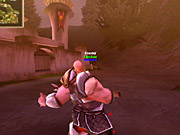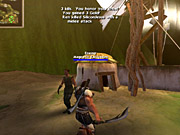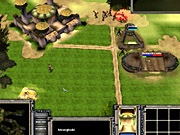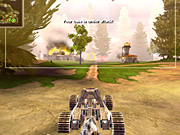Savage Updated Preview
We jump in the beta for an update on this multiplayer hybrid of real-time strategy and first-person shooter action.
In recent years, multiplayer first-person shooters have put more emphasis on team tactics--large-scale team games like Battlefield 1942, for example, reward a certain amount of coordination in securing key map points that makes them more than just frag-fests. But the next big step in this direction is Savage, a game that adds a true real-time strategy element to what's otherwise team-based shooter. Savage lets one player jump into a commander role to control worker units, build structures, gather resources, research weapons for other players, and suggest orders to the other players. As ambitious as this hybrid design sounds, judging from what we've been able to play of a beta version of the game, developer S2 Games seems to be on the right track.

Savage's unusual design essentially brings together first-person shooters with traditional real-time strategy. When you choose to play as a commander, you'll play Savage from the typical top-down perspective you might expect from a real-time strategy game, but the other dozen or more players on a team will be running around a map in either a third-person or first-person viewpoint, one being more natural for melee weapons and the other for ranged. Savage will have a light character-building element reminiscent of Warcraft III or Counter-Strike in that soldier players will need to kill the neutral monsters that respawn at various locations around the map to earn gold and experience points. Of course, the neutral creatures can also serve as an early warning mechanism to help you detect opposing players trying to sneak up in the tall grasses of Savage's lush maps.
Money plays a critical role in how effective soldiers are. Any time you spawn into the game as a soldier or return to a base or outpost, an inventory selection screen pops up that lets you buy weapons, items, and character-class upgrades. The variety of upgrades available is entirely a product of the research selected and financed by the commander (much like in a traditional real-time strategy game), but soldiers have to manage their own funds to put those weapons into practice. The three main character classes come equipped with a free melee weapon, and it doesn't cost anything to grab the first level of any ranged weapon, though it doesn't come with much ammo. The ammo for more-powerful weapons costs a significant amount and character upgrades will cost you nearly all the maximum 10,000 gold you can carry at once, so you might not always want to immediately equip your character with the best money can buy.
Savage is set in a fantasy world, but technology is readily available. The three main human character classes appear as progressively bigger and more muscle-bound barbarian men. The nomad that you start out with is quick enough, but he has a very weak melee attack and just 250 hit points. The savage medium upgrade is a tough-looking warrior with twice the hit points and a much better sword attack that can take out many neutral creatures in one swipe. At the top of the food chain is the legionnaire, who has a slow but devastating attack and 1000 health points.

At the start of the match, the only ranged weapon available for a nomad is the bow and arrow, which can be powerful enough when you hold down the mouse button to charge up the attack, pulling back the string to its fullest extent. But you'll quickly want to get your hands on the first-tier upgrade, the quick-firing crossbow, and hope that the commander will soon move down one of the three technology paths--magnetic, chemical, or energy--to get the bigger weapons along the second and third research tiers, such as the marksman's bow, the shotgun, the plasma rifle, the rocket launcher, and the flamethrower. Unlike most shooters, which tend to balance weapons by giving each a specific use, Savage's basic weapons are simply made obsolete by later discoveries, and poorly equipped players will have a tough time against adversaries who have saved up more gold or with commanders who have researched more options.
Tug of War
All that weaponry will go to waste if you don't turn your attention from killing squirrels and ostriches--and the much more formidable panthers and gorillas--to going after the enemy, its base structures, and its workers. The only way to win the game is to destroy the enemy's central stronghold, and a commander can repair buildings with workers and guard a base with tower defenses, so you'll have more than enemy soldiers to deal with. The real-time strategy aspect of the game not only makes for an interesting upgrade path and gives the commander plenty to do, but it also provides concrete secondary objectives for frontline soldiers, such as scouting out resource points to monitor the enemy's expansion efforts or taking out the worker units to slow down resource harvesting and building. And to keep everyone from just doing their own thing, the commander can issue orders to individual players, who hear attack, move, and defend orders in a booming voice and have waypoints pop up on the minimap.

Every game of Savage starts a team's base at square one--a stronghold, three workers, and nearby patches of gold and red stone. While other players are busy hunting creatures, the commander has the standard RTS base setup to manage, pumping out up to 10 workers to make the resource gathering go quicker and build the various research structures. In fact, because the game's "units" are actual soldier players who do all the fighting, commanders don't need to produce any units themselves. However, commanders do need to build various structures to access various upgrade types, and the cost of all that research can add up quickly. For instance, while the main character-class and tier upgrades are available at the stronghold, you'll need to build a siege factory to unlock the powerful catapult and ballista classes, which are particularly effective in taking down bases. The most costly buildings are the defensive towers, which start off just shooting arrows but can be upgraded for even more gold to powerful grenade towers, magnetic shielding towers, or towers that stop incoming projectiles.
Savage's maps are quite large, so it's fortunate that you don't have to respawn back at the main base every time you get killed off. The commander can build outlying garrison points on any flat terrain, and an obvious strategy is to build a line of spawn points toward the enemy base. However, the maps are covered with creatures that would love to make a snack out of a worker or two, so player soldiers will need to coordinate with the commander's efforts and protect the nearly defenseless peons. The other good use for garrisons is as a drop-off point for resource collection, and since the initial deposits of red stone and gold will eventually run out, it's a good idea to plan ahead and lay claim to other resource points located around the maps. Late in the game you'll find that resources aren't just useful for research and building defenses, but they can also help out individual soldiers. Any soldier who lacks the necessary gold for a desired upgrade can hit a button that requests some money from the team's coffers. It's up to the commander to decide if a player deserves the extra funds, perhaps to take on a siege role, which costs the maximum 10,000 gold.

Savage brings together elements from two massively popular multiplayer genres, and while either component might seem overly simple on its own, the combination seems to make for some pretty unique gameplay. S2Games does have some polishing and balancing left to do before the game's release. For example, the commander interface currently lacks some of the features we expect in modern strategy games, like the option to queue up production or set up rally points for units, though the developer will hopefully add these and other features in the near future. Savage is currently in beta, and the team at S2 Games still has some time to put the finishing touches on the game before its scheduled ship date in July. Stay tuned for more details to be released at next month's E3, when S2 Games will reveal the other playable race, the Beast Horde.
Got a news tip or want to contact us directly? Email news@gamespot.com
Join the conversation